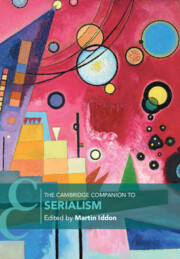Book contents
- The Cambridge Companion to Serialism
- Cambridge Companions to Music
- The Cambridge Companion to Serialism
- Copyright page
- Contents
- Figures
- Tables
- Contributors
- Preface
- Part I Contexts I
- Part II Composers
- 4 Arnold Schoenberg and the ‘Musical Idea’
- 5 Alban Berg’s Eclectic Serialism
- 6 Rethinking Late Webern
- 7 Milton Babbitt and ‘Total’ Serialism
- 8 Pierre Boulez and the Redefinition of Serialism
- 9 The Serial Music of Karlheinz Stockhausen
- 10 Luigi Nono and the Development of Serial Technique
- 11 Stravinsky’s Path to Serialism
- Part III Geographies
- Part IV Contexts II
- References
- Index
5 - Alban Berg’s Eclectic Serialism
from Part II - Composers
Published online by Cambridge University Press: 07 March 2023
- The Cambridge Companion to Serialism
- Cambridge Companions to Music
- The Cambridge Companion to Serialism
- Copyright page
- Contents
- Figures
- Tables
- Contributors
- Preface
- Part I Contexts I
- Part II Composers
- 4 Arnold Schoenberg and the ‘Musical Idea’
- 5 Alban Berg’s Eclectic Serialism
- 6 Rethinking Late Webern
- 7 Milton Babbitt and ‘Total’ Serialism
- 8 Pierre Boulez and the Redefinition of Serialism
- 9 The Serial Music of Karlheinz Stockhausen
- 10 Luigi Nono and the Development of Serial Technique
- 11 Stravinsky’s Path to Serialism
- Part III Geographies
- Part IV Contexts II
- References
- Index
Summary
Alban Berg’s serial works (c. 1925–35) show his ability to use the twelve-tone method of composition as a form of exegesis for his personal, intellectual, and musical heritage in musical narratives suffused with apparent contradictions. In so doing, Berg combined what has been understood as antithetical ideas in an overarching system that brings together his modernistic aesthetics and the art of the past through textures in which twelve-tone serialism and tonality are interwoven. Problematising scholarship that attempts to understand Berg’s music based on Schoenberg’s compositional models, I argue that Berg followed the lead of Fritz Heinrich Klein and Theodor Adorno and embraced contradiction as a ‘category of thought’ in his compositional process. Berg’s approach is evident from the construction of the series to compositions such as the Violin Concerto (1935), which contains a web of musical and extra-musical significations that continues to challenge existing analytical models.
- Type
- Chapter
- Information
- The Cambridge Companion to Serialism , pp. 73 - 86Publisher: Cambridge University PressPrint publication year: 2023
- 1
- Cited by

